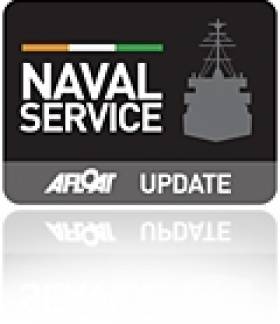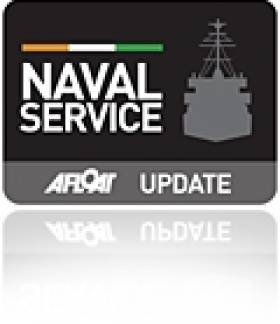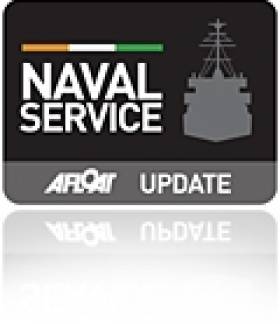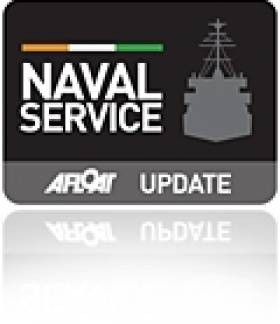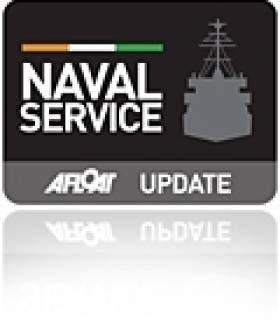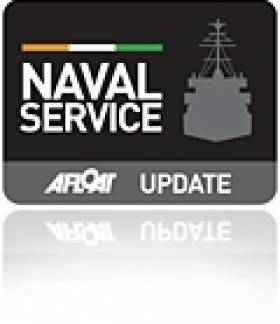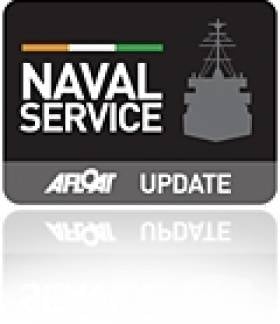Displaying items by tag: naval service
L.E. Emer’s Public Auction to Take Place in Carrigaline, Co. Cork
#AuctionEMER - Cork Auctioneer Dominic Daly is to handle the sale of the decommissioned Naval Service OPV L.E. Emer (P21) which is to be put up for public auction in a month's time, writes Jehan Ashmore.
The auctioneer is to host the public auction in the Carrigaline Court Hotel, Carrigaline on the southern outskirts of Cork City at 12 noon on Wednesday 23 October. The vessel unless previously sold is on view as seen in Cork Harbour. See advert here.
L.E. Emer was the second of four coastal patrol vessels (CPV). They were later re-classified as offshore patrol vessels (OPV). The original leadship, L.E. Deirdre (P20) was decommissioned in 2001 and sold for €190,000. She was converted into a luxury yacht.
In disposing the 35 year old OPV, potentially interested parties could come from a variety of sources and for the following purposes including the conversion for the super-yacht market or as use as an offshore energy supply or a research vessel.
According to the auctioneer's website, a sister of L.E. Emer, the L.E. Aoife (P22) will also go on the market in 12 months time. The two Irish-built vessels were launched at Verolme Cork Dockyard in 1978 and 1980 respectively.
L.E. Emer's keel was laid in March 1977 and six month later she was launched. Her hand-over to the Naval Service took place in January 1978.
Workers spent 26 weeks on the vessel while on the slipway stocks and a further 15 weeks were carried out involving outfitting. Combined, the construction period totalled 280,077 hours and the they say the rest is history in a career that saw her clock up approximately 518,000 miles.
L.E. Emer and L.E. Aoife are to be replaced by a pair of OPV newbuilds currently under construction in a north Devon shipyard.
As previously reported, the PV90 design or enhanced 'Roisin' class are to cost €49m each in a contract that was awarded to Babcock Marine with the first steel cut in May last year which led to the first newbuild L.E. Samuel Beckett which is due to be floated-out next month.
It is understood she is to be delivered next year and followed by second vessel, L.E. James Joyce with a delivery in 2015.
Ex-Officers Group Say Naval Service Should Take Part in UN and EU Missions
#NavalServiceRole – Patrol vessels of the Irish Naval Service should participate in UN- and EU-sponsored "international maritime security" missions, according to the Irish Maritime Forum.
The State's fleet should also be expanded to match the size of New Zealand's navy, given that Ireland's maritime zone has expanded from 410,000sq km to 1 million sq km – more than 12 times the island's land area, the forum says in a submission to Government.
The forum, comprising former naval officers and mariners, says the Government's defence White Paper should redress the imbalance between the Army and Naval Service to reflect the fact that 92 per cent of Ireland is "under water" with "several trillion euro" in natural resource assets, ranging from hydocarbons to fish to wind and wave energy.
Commenting on the recently-published Green Paper on defence, the forum says it is "depressingly clear" that "land-centred thinking is dominant" in its drafting.
The forum says the Naval Service area of operations has "grown exponentially" since the publication of the Government's last White Paper on defence in 2000.
For much more on this story, today's Irish Times has a report.
L.E. Emer Heads Upriver of the Lee for Decommissioning Ceremony
#FarewellEMER – As previously reported, L.E. Emer (P21) of the Irish Naval Service which spent a career spanning more than 35 years, was decommissioned at a ceremony held in Cork City Quays today, writes Jehan Ashmore.
The oldest vessel in the service, the 1978 built LE Emer was the first of a trio launched from Verolme Cork Dockyard (V.C.D) from where she was commissioned on 16 January of that same year.
Notable highlights of her career include the following:
• First Naval Service vessel to carry out UNIFIL re-supply mission in 1979 to South Lebanon.
• Participated in the search and rescue (SAR) operation during the Fastnet Race disaster off the West Cork coast in 1979.
• She played a key role in the seizure of the gun-running fishing vessel "Marita Anne" in 1984.
The 'Emer' CPV class vessel (later reclassified in recent years as an OPV) was designed as an improved version of the CPV L.E. Deirdre(P20).
L.E. Deirdre played a significant historic milestone in that she represented the state's first custom-built naval vessel and which too was launched in 1972 by V.C.D. at the Rushbrooke shipyard near Cobh. She was decommissioned in 2001 and sold for €190,000 and converted into a luxury yacht.
On her final return to Cork Harbour yesterday, L.E. Emer had completed on what would be her last patrol when she berthed along the quay at the foot the Naval Service Base control tower on Haulbowline Island.
L.E. Emer was under the command of captain Lieutenant Commander Alan O'Regan, a Cork native who became the last of 23 captains that have taken charge of the vessel spanning more than three decades.
This afternoon L.E. Emer made the short passage from Haulbowline to Cork City at Customs House Quay North, which en-route involved the 1,019.5 displacement tonnes vessel navigating through Lough Mahon.
Next month she will be put up for sale at a public auction.
Tonight's edition of 'Seacapes' has an interview with Commodore Mark Mellett, Flag Officer Commanding of the Naval Service which includes reviewing the overall fleet. Alternatively you can hear the interview now as a podcast version in advance of the programme to be broadcast on RTÉ Radio 1 starting at 22.30hrs.
LE Emer to Decommission After 36 Years Naval Service
#FarewellEMER – Irish Naval Service vessel LE Emer (P21) is being decommissioned from the service today after almost 36 years in use.
The oldest vessel in the service, LE Emer was built in Verolme Cork Dockyard and was commissioned on January 16th, 1978. The vessel has had 23 captains and the service estimated it has sailed 518,000 nautical miles during its career.
The final serving captain is Lt Cmdr Alan O'Regan, a Cork native. For more on this story,The Irish Times reports.
Afloat.ie adds that the L.E. Emer completed her last stretch of her final patrol duties that saw her depart Dublin Port on Monday of this week. The OPV is currently moored alongside the outer quay of the Naval Service Base on Haulbowline Island.
As previously reported, an interview with Commodore Mark Mellett, Flag Officer Commanding of the Naval Service. To hear the interview click this link to the podcast version in advance of tonight's RTE Radio 1's 'Seascapes' programme starting at 22.30hrs.
Naval Service’s Flag Officer Commander Interviewed on ‘Seascapes’
#NavyInterview – Commodore Mark Mellett, Flag Officer Commanding of the Naval Service will give an interview to be broadcast on RTÉ Radio 1's 'Seascapes' this Friday 20 September (22.30hrs).
Seascapes the maritime programme presented by Marcus Connaughton, is to focus on Mellet in a wide-ranging interview covering the history of the naval base on Haulbowline Island, the role of the Naval Service, new technologies, IMERC and the National Maritime College of Ireland (NMMI).
Also to be discussed will be the overall fleet. Afloat.ie adds that the broadcast coincides with L.E. Emer's last ever patrol which is scheduled to be completed that same day when she arrives to the naval base in lower Cork Harbour.
The Verolme Cork Dockyard built (P21) OPV is then to decommission following a career spanning 35 years.
An extended version of the interview with Mellett can also be heard on Podcast also on Friday afternoon in advance of the radio programme.
A Flying Send-Off as L.E. Emer Bids Dublin Bay Farewell
#FarewellEMER - Today the sell-listed L.E. Emer (P21) departed Dublin Port for the final time and it was also the Naval Service OPV's last patrol, writes Jehan Ashmore.
She headed out of Dublin Bay under the command of Lt .Cdr. Alan O'Regan and where she set a southerly course to pass the Muglins off Dalkey Island.
At the same time of her late morning exodus of the bay, a former World War II serving Catalina flying-boat soared above. The distinctive aircraft was heading eastwards over the Irish Sea, having taken part in yesterday's Flight Fest hosted in the capital.
L.E.Emer is scheduled to complete her patrol duties next Friday at the Naval Base in Haulbowline, Cork Harbour.
She will be decommissioned and next month put up for public auction unless previously sold. A pair of replacement OPV newbuilds are under contruction in the UK with the first of the improved 'Roisin' class due for delivery next year.
Flight Fest Flyover Above Dublin Port Sees Return of ‘Farewell’ L.E. Emer
#FarewellEMER – This Sunday's spectacular Flight Fest Flyover above Dublin Port and city-centre quays is from where the event is to be officially launched by the LE. Emer (P21), writes Jehan Ashmore.
The return to Dublin Port of the sell-listed Naval Service offshore patrol vessel follows a recent call to the capital only last week. On that occasion she made a special farewell cruise in Dublin Bay for former sailors.
So it transpires that this visit to Dublin Port is in fact likely to be her 'final' call to the capital while also performing her last patrol duties.
The 1978 built veteran is to decommission on 20 September and if not previously sold the 65.5m long vessel is to go for public auction next month.
Naval Service Represented in New Stamps to Honour Defence Forces 60 Years of Overseas Service
#NavalService - More than 60 years of overseas service by the Defence Forces are to be honoured in a set of stamps launched today. The four-stamp set depicts the four branches of the forces – the Army, Naval Service, Air Corps and Reserve Defence Force.
Speaking at the stamps launch, Lieut Gen Conor O'Boyle, chief of staff of the Defence Forces, said: "I am very appreciative to An Post for their work in issuing this special commemorative set of stamps as a salute to the modern Irish Defence Forces. For more on the launch, The Irish Times reports.
Afloat.ie adds that among the quartet of stamps appropriately sold at 60 cents each, is the Naval Service represented by the OPV L.E. Niamh (P52). Astern of the 'Roisin' class vessel is the former Royal Navy Peacock class CPV HMS Swift now L.E. Orla (P41).
As previously reported, the sell-listed L.E. Emer made an historic first as she became the first ever Naval Service vessel to re-supply troops serving with the UN in The Lebanon during 1979, the year in which she was commissioned.
Minister Pledges Continued Support for Naval Service of State Sovereignty Over Maritime Jurisdiction
#NavalService – Today's Irish Times reports that the Government remains committed to supporting the Naval Service. Minister of State for Defence Paul Kehoe pledged to ensure Ireland's sovereignty is maintained over the State's maritime jurisdiction.
Mr. Kehoe said the success of the Naval Service in the areas of fishery protection, search and rescue and in providing aid to the civil power was evident to all and had helped convey the importance of the Naval Service to the wider community.
"Our ships signal to everybody that we are committed to good governance in our oceans and they serve as a warning to those who think about flouting the norms and principles of the Irish State and the wider international community," Mr Kehoe said.
Mr Kehoe was speaking at the Naval Service commissioning ceremony where six former cadets received their scrolls of commission before a large gathering of dignitaries, as well as family and friends, at the Naval Service headquarters at Haulbowline in Cork Harbour.
L.E. Emer: A Career Stretching Beyond Fishery Patrols to The Lebanon
#FarewellEMER – Dublin Port is to bid farewell to L.E. Emer (P21) on her final visit to the capital today. Under command of Lt. Cdr. Alan O'Regan she is to resume her last patrol prior to de-commissioning on 20 September, writes Jehan Ashmore.
The sell-listed offshore patrol vessel (OPV) of 1,019 displacement tonnes has served the Naval Service dutifully for nearly 35 years.
Since her launch from the V.C.D. shipyard in 1977, the vessel which entered service two years later, has carried out numerous patrols. Not just fishery monitoring patrols but varied tasks among them the interdiction of illegal drugs and contraband to search and rescue (SAR).
Naval Service vessels are not restricted to domestic waters but also re-supply missions to Irish Army troops serving the United Nations (UN) overseas.
A notable historic first role was undertaken by L.É. Emer, as she became the first ever Naval Service vessel to re-supply troops serving with the UN in The Lebanon during 1979, the year in which she was commissioned.
The 65m vessel is fitted with the following weaponary where the main armament consists of a Bofors 40mm L70 Canon, secondary armament is 2 X 20mm Rheinmetall RH202 Canon. In addition to small various arms ranging from 9mm Pistol to 7.62mm General Purpose Machine Guns mounted amidships.
Another significant operation by the L.E. Emer was the apprehension of the trawler, Marita Ann in 1984, which was stopped after warning shots were fired, having found to be carrying a significant quantity of arms and ammunition.


























